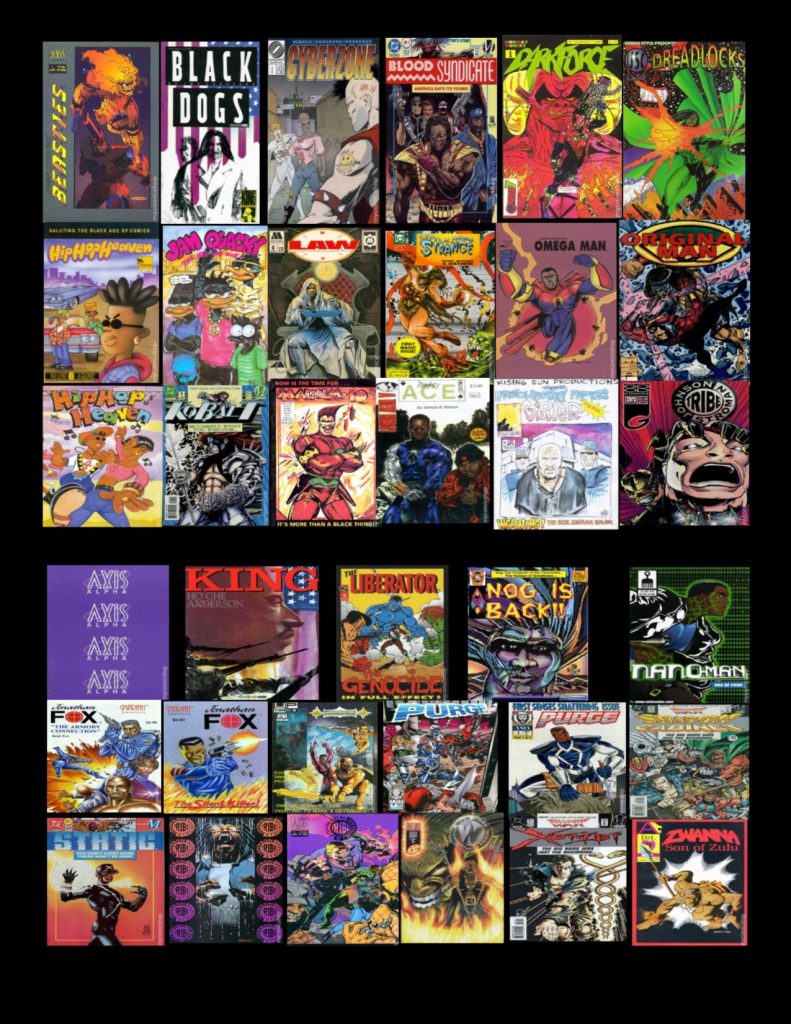
Depending on whom you talk with, the 90’s were either a new beginning in the world of comic books or it was the beginning of the end. Many will point out the financial woes of Marvel, or the direct market comic distributors and their effect on sales to comic book shops, or a number of other items that affected what had become mainstream comics. The age of the comic collector had begun and in response the comic companies began to glut the market with new #1 issue comics and multiple comic cover variants in hopes to appeal to collectors, although said comics often lacked quality, The 90’s saw the emergence of a darker tone of comics that had begun in the late 80’s. The comics were grittier and darker and sought to appeal to an adult audience, making said audience now more of a smaller niche fan base versus one of general appeal. All these things combined to bring comic sales down to an all time low by the end of the century.
For fans of mainstream comics this was an unsettling time indeed, but for an often overlooked segment of the comic book population, the 90’s represented the beginning of a revolution; a “movement” that would launch what was termed the “Black Age” of comics.
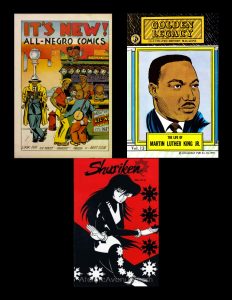
A movement which would bear witness to an explosion of color in comics that was unseen, unexpected, and unhindered. This movement had been steadily building momentum since 1947 when Orrin Evans published his historic All Negro Comics, and even picking up steam with the Golden Legacy comics published by Bertram Fitzgerald and Fitzgerald Publishing, and the innovative ideas his company employed to not only secure financial backing for the distribution of their comic, but also in the marketing of the books back in the 60’s and 70’s, and gaining a huge spark from Victory Publishing and Reggie Byars, who self published his comic, Shuriken under Victory Productions, which made him one of the first in the modern comic era to own a publishing company. The movement encapsulated the very best of the efforts of these previous companies; the desire to control the images and depictions of African Americans, the business acumen to create avenues to distribute their publications, and the overall self sufficiency to do things for themselves and the satisfaction that brings.
The decade was not without it’s first for African Americans. Tribe #1, published in 1993 and created by Larry Stroman and Todd Johnson, was the highest selling black owned comic ever; selling over a million copies. Cassandra Washington of Castel Publications and Monique McCellan of Mariah Graphics are two of the first African American female comic book publishers. Castel Publications released Sustah Girl in 1993 which was co-written by Turtel Onli (more on him in a moment) and Mariah Graphics released the first of its Johnathan Fox series written and drawn by her former husband John McCellan. The release of Brotherman in 1990 by Big City comics is considered the official start of the movement; consideration that earned the comic a spot in the Smithsonian National Museum of African American History and Culture. The biggest of all first has to do with Turtel Onli, whose company Onli Studios, first published its comic Nog Protector of the Pyramides in 1981, and in doing so created a hero unlike any other that came before him.
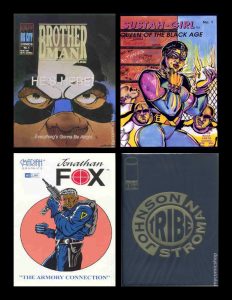
A hero that was based from and cast in the image of Afrocentricity. Mr Onli in 1993 organized and event that would showcase some of the black creators and comics of the day. He dubbed the event the “Black Age of Comics“, with participants representing 15 comic titles, and began what would become and annual event that still carries on to this day.
The movement was not without its share of friction as well. At the root of the friction was the desire to control how Blacks were being portrayed in comics. The portrayals and images were typically stereotypical, out of date, or culturally inappropriate. The leading proponents for change were ANIA and Milestone Media. The friction came in the form of one company ANIA, which was an association of 5 black owned comic companies under one banner, and Milestone Media Inc. which was formed by a group of black writer and artist led by the late Dwayne McDuffee and their differing ideology and their perspective approach to resolving long held misrepresentations. . The initial disagreement arose from the ANIA group claiming that Milestone’s characters were not “black enough” and accused the company of being Uncle Toms because of their association with DC comics.
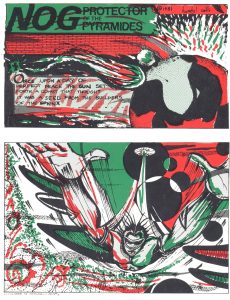
The association that is referred to is the licensing and distribution agreement Milestone signed with DC comics which allowed their comics an avenue into mainstream comics (Brent Dorian Carpenter’s Foundation Studios did the same thing with Gauntlet Comics with his comic UN Force). ANIA, which means serve and protect in Swahili, maintained that Black comic readers need to see heroic images of themselves that were based from a more Afrocentric perspective. They claimed that the images that Milestone portrayed; specifically the Milestone character, Icon; were no less than chocolate-dipped Supermen. ANIA felt that Milestone and its characters were not doing enough to erase the years of stereotypes that had existed in comics almost since its inception, and that their characters were not truly representative of Black culture. The claims were dismissed by Milestone, who insisted that they were breaking long held views for people from any races, and would leave it up to the reader to decide if they were Afrocentric, multicultural, or just really good entertainment.
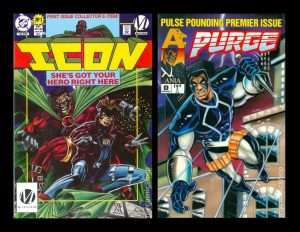
ANIA was not without receiving criticism of it own for not only seemingly inciting the “black on black” dispute with Milestone, but was accused of racism because they were composed entirely of African Americans. Roosevelt Pitt, creator of Purge, is quoted back in 1993 as saying during that time they were not multicultural like Milestone, but were Afrocentric because they are African Americans, and that’s all they know. Although the companies represented two differing ideologies, they suffered from internal friction as well that led to founding members of each company eventually leaving and both companies experiencing some push back from the direct market. Even with all of this, they were still able to maintain solid sales numbers on their titles.
In all, the 90’s saw an explosion of comics written, drawn, and published by more people of color than at any other point in comic book history. The books represented some of the best work of that time, and was very effective in what it set out to do in changing the perception of what it meant to be a black comic book character, and that these characters can be as varied as the real people they represent and the real situations they face. Even actress Jada Pinkett Smith, at the time still in her 20’s contributed to the explosion with her comic, Menace. Some of these characters survived the 90’s and are still around to this day, such as John McCellan’s Jonathan Fox, Andre Batts’ Dreadlocks, Roosevelt Pitts’ Purge, and from Milestone Media Icon, Rocket, and Static, who were absorbed into the mainstream DC Comics. Both the new management of Milestone and the creators Tribe have announced relaunches of there brands, as well.
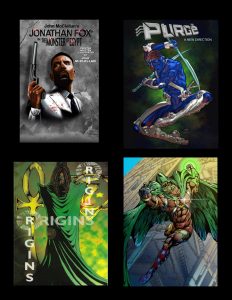
Below is a partial listing of the African American owned comic book companies and comics created by African Americans, and year the books were published. In the case of ANIA, the individual companies that made up the group are listed separately as well as the books being listed under both companies.
ACME– Heru Son of Ausar (1986); Horus Son of Osiris (1991)
African Prince Production– Captain Africa (1992)
Africa Rising– Ebony Warrior (1993)
Afrocentric Comics– Heru Son of Ausar (1993); The Grand Nubians (1994)
Amara– Purge Preview (1995)
ANIA (Dark Lies Zulu, UP Comics, Africa Rising, Afrocentric Comics, and Omega 7 Comics)– Purge #0, #1; Heru Son of Ausar; Ebony Warrior #1, #2; Original Man; Zwanna Son of Zulu (all issue 1993)
Awesome Comics/Entertainment- Menace (1998)
Axis- Tribe #2, #3 (1993) Axis Alpha (1994); Beasties (1994)
Bates and Shabazz Publishing Co. (later renamed to Oakland Comics Co. and then O.G. Entertainment)- The Black Savior (1991)
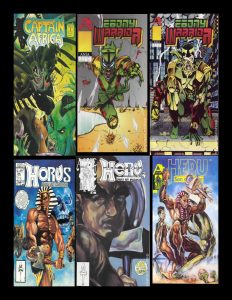
Big City Comics (later renamed Big City Entertainment Inc.)- Brotherman (1990)
B-Line Edutainment– Crescent (1996)
Boomtown Productions– Hip Hop Heaven #1, #2 (1993)
Castel Publications- Sustah Girl (1993); The Grammar Patrol (1994)
CQ Comics Group- Black Man (1997)
Dark Angel Productions- Black Jack #1,#2,#3 (1996); Black Jack Blood and Honor #1,#2 (1997); Race Against Time (1997)
Dark Zulu Lies– Zwanna Son of Zulu (1993)
Diehard Studios- Captain Africa (1990)
Fantagraphics- Black Dogs (1993); King (1993); I Want to be your Dog (1996)
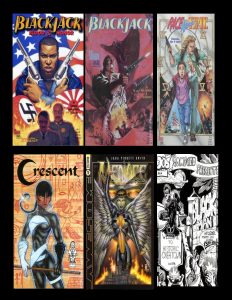
Foundation Studio– Tekq (1992); UN Force (1993); Paradigm (1993)
Gettoske Comics–Chocolate Thunder (1999); Nanoman (2000)
Good Comics– Tribe #0 (1993); W (1996)
Kamite Comics– Numidian Force (1991)
Hype Comics– Inner City Products (1991)
Image– Tribe #1 (1993)
Images & Realities– The Liberator #1, #2 (1993)
Jet Black Grafix– Cyberzone #1-#8 (1994)
JQ Productions– Jam Quacky (1991)
Mariah Graphics– Jonathan Fox #1,#2,#3 (1993)
Milestone Media Inc.– Blood Syndicate, 35 issues, (1993); Hardware, 50 issues, (1993); Icon, 42 issues, (1993); Static, 45 issues, (1993), Kobalt, 16 issues, (1994); Shadow Cabinet, 18 issues, (1994); Xombi, 22 issues, (1994)
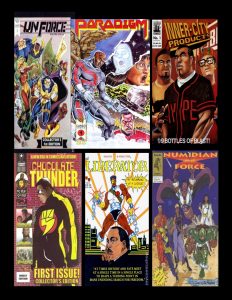
Millennium– Little Miss Strange (1997)
Motown/Machineworks– Law Convention preview (1996)
Omega 7 Comics– Darkforce #1, #2 (1992) Mighty Ace #1, #2 (1992); Omega Man (1992); Original Man #1-#4 (1992)
Onli Studios- Nog the Protector of the Pyrimides (1981/82); Malcolm 10 (1992); Nog Is Back! (1994)
Rising Sun Productions– The Cipher (1992)
Slave Labor– Harry The Cop (1994)
Urban Style Comics– Dreadlocks: Welcome to the Terrordome (1996)
UP Comics– Power Knights (1992); Purge (1992)
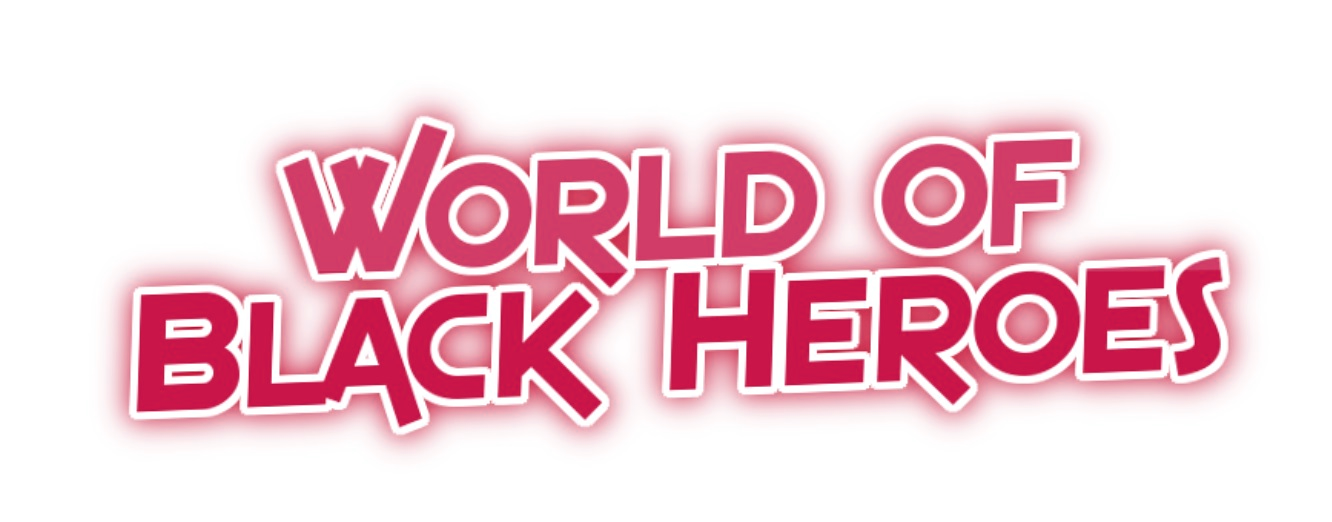
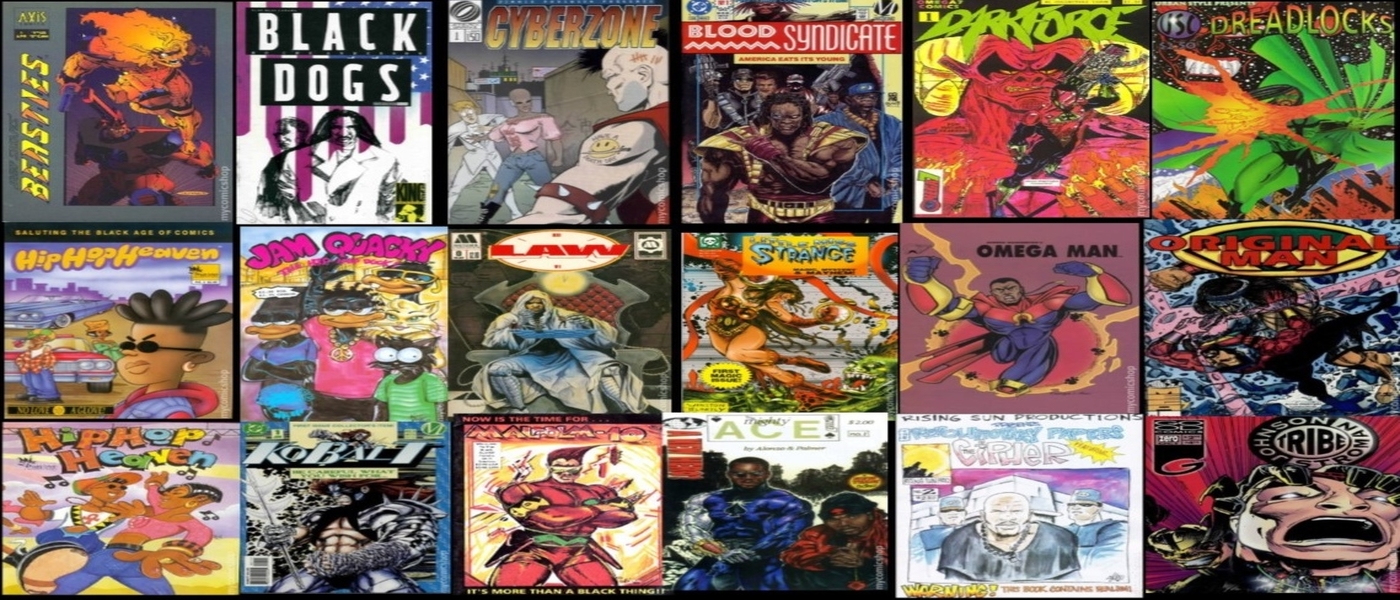
Nice article!
How I miss those days of being able to go into Pyramid Bookstore in PG County MD and find comic books for me and my son. I thought African American owned bookstores and African American themed comics would be here forever. Luckily I still have a full set of Golden Legacy, several Numidian Force, Heru, Captain Africa and a few others. There is hope on the horizon; some new African American owned bookstores are opening. Thank goodness!
Agreed Regina!